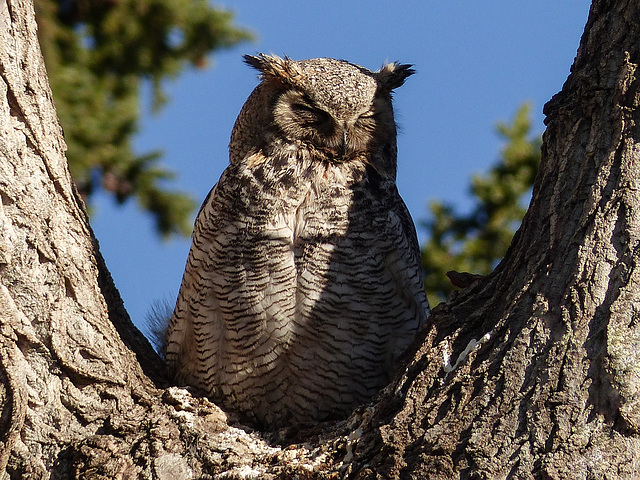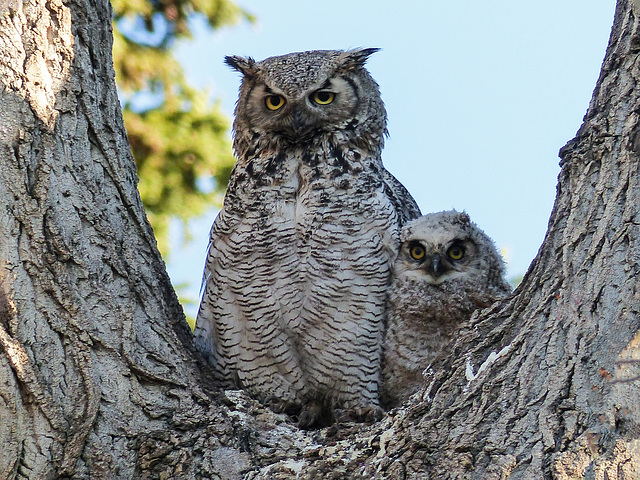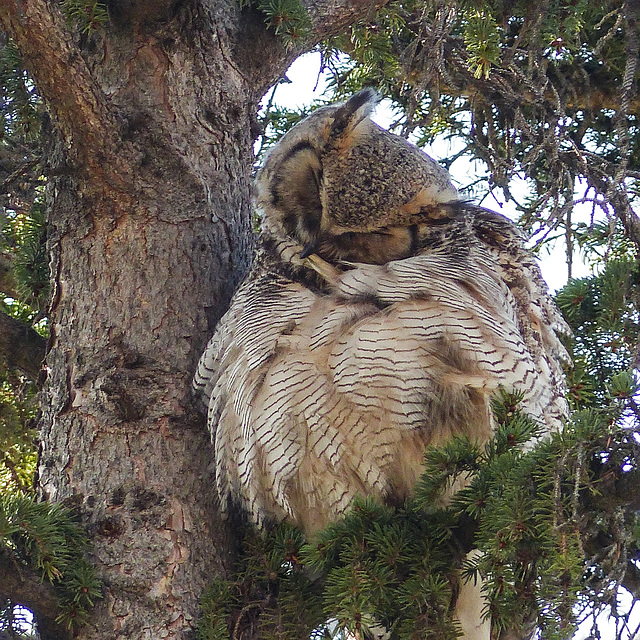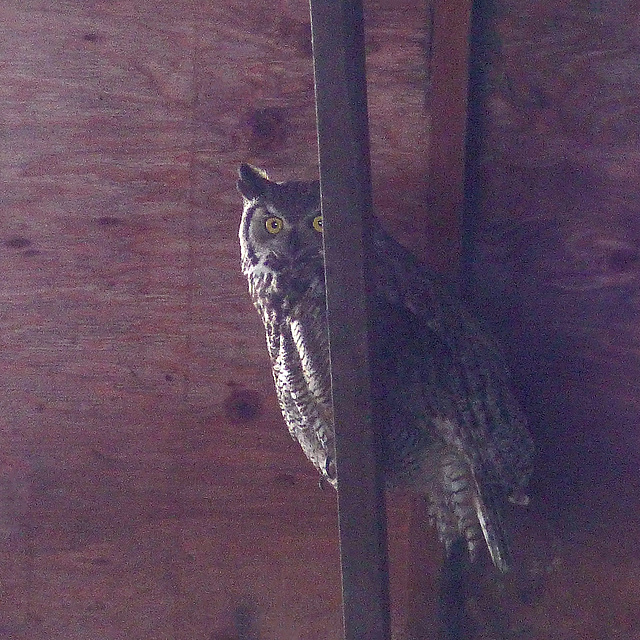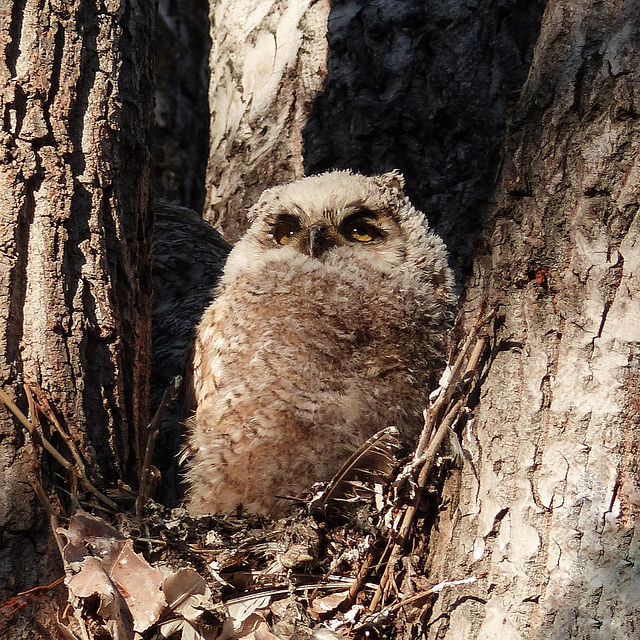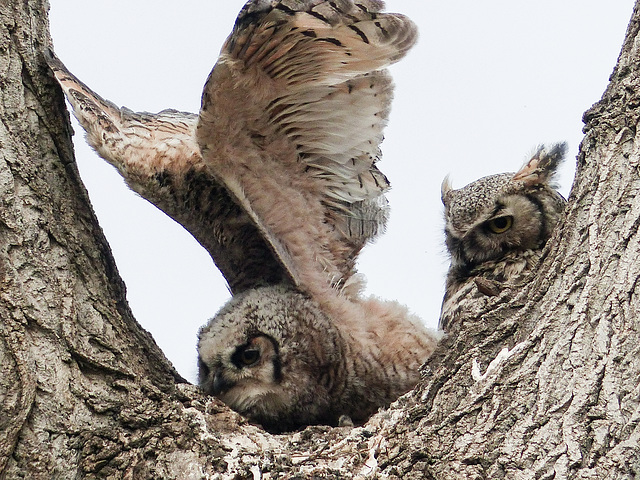
Owls 3
27 Apr 2014
Remembering happy times
Almost exactly ONE YEAR AGO, on 27 April 2014, I called in to see the family of Great Horned Owls in a local park and finally got to see the two owlets up on the rim of the nesting cavity. The last time I had seen them, just their heads were visible inside the nest. Various friends had been posting photos of these youngsters climbing up on top of the broken tree, so I knew that if I didn't go very soon, the owlets would have fledged to a different tree and then would be difficult or impossible to photograph. It turned out that these two fluffy owlets did fledge, a couple of days after I took this photo.
The reason that I'm posting this photo is that, sadly, the Great Horned Owl pair that has nested at this location for quite a few years, has had an unsuccessful breeding season this year (2015). We aren't sure what happened, as we did see the male sitting in a tree near the nesting tree and we did see the top of the female's head fairly recently. Then, suddenly, I heard that people were seeing both adults sitting in nearby trees. I have only been down there maybe a couple of very brief times in at least the last couple of months. Maybe people who are there for many hours, day after day, actually saw something happen? Apparently, someone did report seeing three adults in that area recently. Or maybe the eggs did not successfully hatch, or maybe they did hatch and the tiny owlets picked up some infection from deep down in the nesting tree? Feel sad for the adult owls, and I know hundreds, if not thousands, of people will also be feeling sad and so disappointed. These owls have given us so much enjoyment over the years. Hopefully, next year, if the owls stay at this location, they will have a much more successful and happier breeding season.
"With its long, earlike tufts, intimidating yellow-eyed stare, and deep hooting voice, the Great Horned Owl is the quintessential owl of storybooks. This powerful predator can take down birds and mammals even larger than itself, but it also dines on daintier fare such as tiny scorpions, mice, and frogs. It’s one of the most common owls in North America, equally at home in deserts, wetlands, forests, grasslands, backyards, cities, and almost any other semi-open habitat between the Arctic and the tropics.
Great Horned Owls are nocturnal. You may see them at dusk sitting on fence posts or tree limbs at the edges of open areas, or flying across roads or fields with stiff, deep beats of their rounded wings. Their call is a deep, stuttering series of four to five hoots." From AllAboutBirds.
www.allaboutbirds.org/guide/Great_Horned_Owl/id
en.wikipedia.org/wiki/Great_horned_owl
15 Apr 2015
Tired out Mom
Yesterday, 15 April 2015, my parking lot was going to be spring-cleaned, which meant that all cars had to be out of the lot by 7:30 am. I don't have a 2015 street parking permit, so I had to leave home at 7:30 and find something that would use up the few hours before my volunteer shift. I didn't want to risk being late for that, so decided to stay within the city rather than go driving some backroads. The owls in Fish Creek Park ended up being my destination. I had only been there twice in many weeks and seen Mom on my first visit and then Mom with two of her three owlets on the second. When I arrived yesterday morning, there was no sign of the "paparazzi" - I had been expecting there to be at least a few photographers and people out for a walk. This time, I was able to see all three owlets as well as Mom and Dad. Late afternoon, after my volunteer shift, I called in again for a while on my way home.
The strong shadow in this image was unfortunate, but at least most of this adult female Great Horned Owl's face is lit by sunshine. Not sure if her right eye is completely closed or, as is so often the case with an owl, one eye or both could be just the tiniest bit open.
This is a busy Mom with three young ones. Dad sits in one or other of the nearby trees, keeping careful watch over his mate and owlets. He hunts at night and brings food to the rest of his family.
"With its long, earlike tufts, intimidating yellow-eyed stare, and deep hooting voice, the Great Horned Owl is the quintessential owl of storybooks. This powerful predator can take down birds and mammals even larger than itself, but it also dines on daintier fare such as tiny scorpions, mice, and frogs. It’s one of the most common owls in North America, equally at home in deserts, wetlands, forests, grasslands, backyards, cities, and almost any other semi-open habitat between the Arctic and the tropics.
Great Horned Owls are nocturnal. You may see them at dusk sitting on fence posts or tree limbs at the edges of open areas, or flying across roads or fields with stiff, deep beats of their rounded wings. Their call is a deep, stuttering series of four to five hoots." From AllAboutBirds.
www.allaboutbirds.org/guide/Great_Horned_Owl/id
en.wikipedia.org/wiki/Great_horned_owl
15 Apr 2015
1 favorite
How sweet is this?
Four days ago, on 15 April 2015, my parking lot was going to be spring-cleaned, which meant that all cars had to be out of the lot by 7:30 am. I don't have a 2015 street parking permit, so I had to leave home at 7:30 and find something that would use up the few hours before my volunteer shift. I didn't want to risk being late for that, so decided to stay within the city rather than go driving some backroads. The owls in Fish Creek Park ended up being my destination. I had only been there twice in many weeks and seen Mom on my first visit and then Mom with two of her three owlets on the second. When I arrived four mornings ago, there was no sign of the "paparazzi" - I had been expecting there to be at least a few photographers and people out for a walk. This time, I was able to see all three owlets as well as Mom and Dad. Late afternoon, after my volunteer shift, I called in again for a while on my way home.
Note added on 19 April: I've just checked the EXIF data for my photos from that morning and talk about being lucky! When I got to the park, I took my first photo at 7:52 am. The photo above was my sixth photo, and was taken at 7:54 am.. I think I was actually standing on the paved path for this. I heard today that a 10 minute limit has now been put on watching and photographing the owls at this location, thanks to the people who are there from morning till late afternoon every day (or almost every day). I had a bad feeling that these people were going to end up spoiling things for everyone else, and now it has happened. Can't say I agree with the "10 minute thing", but all day every day is going way too far. Sigh ....
This is a busy Mom with three young ones – not sure which owlet this is. Dad sits in one or other of the nearby trees, keeping careful watch over his mate and owlets. He hunts at night and brings food to the rest of his family. The feathers around Mom’s beak are very dark, discoloured from the dried blood from all the feedings.
"With its long, earlike tufts, intimidating yellow-eyed stare, and deep hooting voice, the Great Horned Owl is the quintessential owl of storybooks. This powerful predator can take down birds and mammals even larger than itself, but it also dines on daintier fare such as tiny scorpions, mice, and frogs. It’s one of the most common owls in North America, equally at home in deserts, wetlands, forests, grasslands, backyards, cities, and almost any other semi-open habitat between the Arctic and the tropics.
Great Horned Owls are nocturnal. You may see them at dusk sitting on fence posts or tree limbs at the edges of open areas, or flying across roads or fields with stiff, deep beats of their rounded wings. Their call is a deep, stuttering series of four to five hoots." From AllAboutBirds.
www.allaboutbirds.org/guide/Great_Horned_Owl/id
en.wikipedia.org/wiki/Great_horned_owl
22 Apr 2015
2 favorites
1 comment
Preening her feathers
Late afternoon yesterday, 22 April 2015, after a volunteer shift, I called in at a local park to see the Great Horned Owl family. I hadn't been over there for a week, so I was curious to see if much had changed with them. Not a whole lot, though Mom, like Dad, was perched in a nearby Spruce tree. With Great Horned Owls, the adults tend to be sitting still for most of the daytime hours, so it's always a treat when one of them actually moves, even if it's just a minute or two of preening.
This is Mom in my photo. She is a busy Mom with three young ones to care for. Dad has always been sitting in one of the nearby trees, keeping careful watch over his mate and owlets. He has been hunting at night and bringing food to the rest of his family. As owlets get bigger and bigger, the female tends to leave the nest to hunt for food, too. Females are larger than males, so can catch larger, heavier prey to feed to her quickly growing young ones.
"With its long, earlike tufts, intimidating yellow-eyed stare, and deep hooting voice, the Great Horned Owl is the quintessential owl of storybooks. This powerful predator can take down birds and mammals even larger than itself, but it also dines on daintier fare such as tiny scorpions, mice, and frogs. It’s one of the most common owls in North America, equally at home in deserts, wetlands, forests, grasslands, backyards, cities, and almost any other semi-open habitat between the Arctic and the tropics.
Great Horned Owls are nocturnal. You may see them at dusk sitting on fence posts or tree limbs at the edges of open areas, or flying across roads or fields with stiff, deep beats of their rounded wings. Their call is a deep, stuttering series of four to five hoots." From AllAboutBirds.
www.allaboutbirds.org/guide/Great_Horned_Owl/id
en.wikipedia.org/wiki/Great_horned_owl
05 Apr 2015
Deep inside a dark barn
Taken from outside a barn, looking inside right to the far end, so really bad photo quality, but being posted for my records.
On 5 April 2015, I woke up to a winter scene, as it had snowed overnight. I wasn't sure if the drive would be cancelled, but fortunately we went ahead as planned. Only five of us went on this trip to Frank Lake, SE of Calgary. The whole area at and around Frank Lake is one of my favourite places. It was snowing on and off during the day and visibility was not very good. Pretty well all the birds we saw were distant or very distant, as usual when I go on one of these outings. A very enjoyable day as always, though, in an interesting place and with good company. I will add the leader, Tony Timmons' list of our sightings, below, mainly for my own memory. Thanks for the great day, Tony!
"Five participants for the Easter Sunday,Nature Calgary Trip to Frank Lake.
We found 47 species. Best sighting for the group was an adult Golden Eagle perched on the ground close to the road, (along 184st.E and west of the intersection with 594 Ave.E. on route to Basin3)
A Eurasian Wigeon was along the access road to Basin 2,and a pair of Red-breasted Mergansers were spotted in Basin 1.
Canada Goose
Trumpeter Swan 15
Tundra Swan 2
Eurasian Wigeon 1
American Wigeon
Mallard
Northern Shoveler
Northern Pintail
Green-winged Teal
Canvasback
Redhead
Ring-necked Duck
Lesser Scaup
Bufflehead
Common Goldeneye
Barrow's Goldeneye 1m
Common Merganser 5
Hooded Merganser 8
Red-breasted Merganser 2
Ruddy Duck 1
Bald Eagle 1 ad.
Golden Eagle 1 ad.
Northern Harrier 7
Red-tailed Hawk 2
American Kestrel 2
Gray Partridge 8
American Coot
Killdeer 2
American Avocet 2
Franklin"s Gull 8
Ring-billed Gull 10
California Gull 100
Rock Pigeon
Great Horned Owl 3 ad.
Northern Shrike 1
Black-billed Magpie
American Crow
Common Raven
Horned Lark 25
American Robin
European Starling
Dark-eyed Junco 1
Lapland Longspur (small flock overhead 5-6)
Red-winged Blackbird 10
Yellow-headed Blackbird 5
Western Meadowlark 6
House Sparrow
Tony Timmons"
24 Apr 2015
1 favorite
1 comment
Adventurous little owlet
As of yesterday, this little Great Horned Owl "branchling" seems to have become a nestling once again : ) It has experienced various adventures in the last 10 days or two weeks, but seems to be back on owlet schedule now. I guess we will never know what happened to start all this, though it is possible that this young one was blown out of the nest when we had several days of extremely strong winds recently.
This photo, from 24 April 2015, was taken when I called in very briefly at the park and found the owl on a high Spruce branch. Maybe it "missed" its two younger siblings, so returned to its place of origin : ) No activity from any of the owls, so the 10-minute "limit" on being there and taking photos was more than enough time for me to be there : ) Fully zoomed - Focal Length (35mm format) - 1200 mm.
Yesterday, on the way home from a great day with friends at Frank Lake, I called in at the park again for about half an hour. A bit more activity this time, with all three still together. I knew my "watching" time was up, but I also knew that the number of days before the Tax deadline were running out fast. Got my Taxes ready and finally fell into bed around 5:00 this morning!
"With its long, earlike tufts, intimidating yellow-eyed stare, and deep hooting voice, the Great Horned Owl is the quintessential owl of storybooks. This powerful predator can take down birds and mammals even larger than itself, but it also dines on daintier fare such as tiny scorpions, mice, and frogs. It’s one of the most common owls in North America, equally at home in deserts, wetlands, forests, grasslands, backyards, cities, and almost any other semi-open habitat between the Arctic and the tropics.
Great Horned Owls are nocturnal. You may see them at dusk sitting on fence posts or tree limbs at the edges of open areas, or flying across roads or fields with stiff, deep beats of their rounded wings. Their call is a deep, stuttering series of four to five hoots." From AllAboutBirds.
www.allaboutbirds.org/guide/Great_Horned_Owl/id
en.wikipedia.org/wiki/Great_horned_owl
14 Jan 2015
Northern Pygmy-owl from January
On 14 January 2015, I called in at Fish Creek Park for some fresh air and, hopefully, find a friend or two. I was lucky with both. People had already found one of the little owls. Somehow, everyone seemed able to manoeuvre their tripods and enormous lenses each time the owl moved to a different branch or a new tree. I love my easy little point-and-shoot : ) Some of my photos were taken at Focal Length (35mm format) - 1200 mm, so the owl looks closer than it really was. We were all treated to some good views, and it was fascinating to watch the owl get ready to fly down to the snow-covered ground when it saw some movement. It goes through some interesting body behaviour in the seconds before that rapid dive. I can't remember if it did actually dive down this time.
I was impressed that all the photographers were very respectful of this tiny owl. Some of its time was spent perched extremely high in tall trees. Usually, it was just about within my camera reach and we were all lucky enough to see it perched in a variety of places, including some closer views. Any very close photos that are on my photostream, taken on various days, were taken when the owl unexpectedly flew right to where people were standing, seemingly without any stress. You would think that the owls would move away to a different area if they were bothered by the presence of people. Instead, they seem very tolerant, and continue to hunt, stash food (Meadow Voles) and even mate when people are present.
"The Northern Pygmy-Owl may be tiny, but it’s a ferocious hunter with a taste for songbirds. These owls are mostly dark brown and white, with long tails, smoothly rounded heads, and piercing yellow eyes. They hunt during the day by sitting quietly and surprising their prey. As a defensive measure, songbirds often gather to mob sitting owls until they fly away. Mobbing songbirds can help you find these unobtrusive owls, as can listening for their call, a high-pitched series of toots." From AllAboutBirds.
www.allaboutbirds.org/guide/Northern_Pygmy-Owl/id
15 Apr 2015
Yellow, glassy eyes
Just over two weeks ago, on 15 April 2015, my parking lot was going to be spring-cleaned, which meant that all cars had to be out of the lot by 7:30 am. I don't have a 2015 street parking permit, so I had to leave home at 7:30 and find something that would use up the few hours before my volunteer shift. I didn't want to risk being late for that, so decided to stay within the city rather than go driving some backroads.
The owls in Fish Creek Park ended up being my destination. I had only been there twice in many weeks, seeing Mom on my first visit and then Mom with two of her three owlets on the second. When I arrived early morning on 15 April, there was no sign of the "paparazzi" - I had been expecting there to be at least a few photographers and people out for a walk. Maybe the 10-minute viewing limit has had some effect : ) This time, I was able to see all three owlets as well as Mom and Dad. Can't remember which owlet this one was, but it was just the cutest bundle of fluff. Late afternoon, after my volunteer shift, I called in again for a short while on my way home. It has been five days since I last called in, so I'm sure there have been changes.
"With its long, earlike tufts, intimidating yellow-eyed stare, and deep hooting voice, the Great Horned Owl is the quintessential owl of storybooks. This powerful predator can take down birds and mammals even larger than itself, but it also dines on daintier fare such as tiny scorpions, mice, and frogs. It’s one of the most common owls in North America, equally at home in deserts, wetlands, forests, grasslands, backyards, cities, and almost any other semi-open habitat between the Arctic and the tropics.
Great Horned Owls are nocturnal. You may see them at dusk sitting on fence posts or tree limbs at the edges of open areas, or flying across roads or fields with stiff, deep beats of their rounded wings. Their call is a deep, stuttering series of four to five hoots." From AllAboutBirds.
www.allaboutbirds.org/guide/Great_Horned_Owl/id
en.wikipedia.org/wiki/Great_horned_owl
23 Apr 2015
Look, Mom, I can fly!
Well, almost, lol!
On 23 April 2015, I went on a birding walk with friends at Carburn Park. On the way home, I called in to see the Great Horned Owl family for just a short while mid-afternoon, on 23 April 2015. The oldest owlet was still out on a coniferous tree branch that was right by the nesting tree, and the two younger owlets were still in the nest. I think this must have been the "middle" owlet, exercising those wings that were not quite ready for flight, with Mom looking on. Called in again yesterday, 2 May 2015, after a great, full-day birding trip south of the city. Dad was in a fairly nearby tree, and the two youngest owlets were still on the nest. Only stayed a few minutes and didn't see Mom and the oldest owlet. No activity going on at all - and there were no other photographers there.
"With its long, earlike tufts, intimidating yellow-eyed stare, and deep hooting voice, the Great Horned Owl is the quintessential owl of storybooks. This powerful predator can take down birds and mammals even larger than itself, but it also dines on daintier fare such as tiny scorpions, mice, and frogs. It’s one of the most common owls in North America, equally at home in deserts, wetlands, forests, grasslands, backyards, cities, and almost any other semi-open habitat between the Arctic and the tropics.
Great Horned Owls are nocturnal. You may see them at dusk sitting on fence posts or tree limbs at the edges of open areas, or flying across roads or fields with stiff, deep beats of their rounded wings. Their call is a deep, stuttering series of four to five hoots." From AllAboutBirds.
www.allaboutbirds.org/guide/Great_Horned_Owl/id
en.wikipedia.org/wiki/Great_horned_owl
Jump to top
RSS feed- Latest items - Subscribe to the latest items added to this album
- ipernity © 2007-2024
- Help & Contact
|
Club news
|
About ipernity
|
History |
ipernity Club & Prices |
Guide of good conduct
Donate | Group guidelines | Privacy policy | Terms of use | Statutes | In memoria -
Facebook
Twitter



